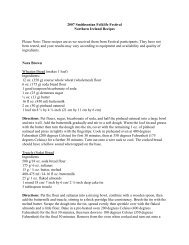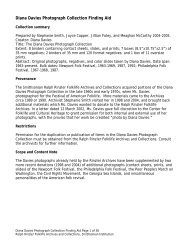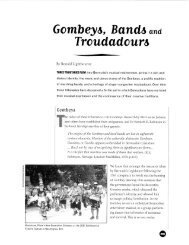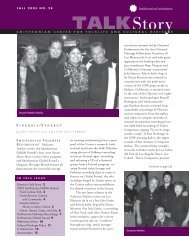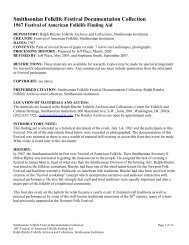Who Owns Traditional Medical Knowledge? - Smithsonian Center ...
Who Owns Traditional Medical Knowledge? - Smithsonian Center ...
Who Owns Traditional Medical Knowledge? - Smithsonian Center ...
You also want an ePaper? Increase the reach of your titles
YUMPU automatically turns print PDFs into web optimized ePapers that Google loves.
176 SITA REDDY<br />
practices, each with their own professional associations, schools, and political lobby<br />
groups. 56 Although the shuddhas had several charismatic leaders through the 1950s,<br />
they had withered into an insignificant group by the 1980s that had lost the professionalizing<br />
high ground and were widely perceived to be the casualties of development<br />
and liberalization. 57 By 2003, policy recommendations had begun to<br />
clearly favor integrated Ayurvedic institutions, curricula, standards, and practice,<br />
and integrated practitioners dominated the public face of Ayurvedic politics. 58 Faced<br />
with the TKDL, however, some shuddhas seem to have found a new cause around<br />
which to mobilize. As Luddites among the Ayurvedic revivalists, they criticize both<br />
the technology and the very premise of an authentic Ayurvedic database. Their<br />
argument follows a logic commonly known in the heritage literature as the “sacrilege<br />
or defamation” grounds for exclusive use. 59 In their view, sacred Ayurvedic texts<br />
should not be defamed by exposing them to secular or public scrutiny; access to<br />
these texts should be restricted only to scholarly practitioners who have immersed<br />
themselves in this knowledge for decades; and thus they were the rightful interpreters<br />
of these sacred objects. Some of these practitioners have already registered<br />
a complaint about TKDL (through their professional association) and are ready<br />
to contest this “contamination” of Ayurvedic tradition to prevent it from being<br />
used in global arenas such as WIPO. 60 One prominent practitioner has even threatened<br />
to wage a legal dispute in the Indian courts to reclaim exclusive use over<br />
sacred texts by making Ayurveda itself (and its reigning god Dhanavantri) the plaintiff.<br />
61 This may not be just fanciful or far-fetched: It is possibly a reference to two<br />
famous tangible heritage disputes over art antiquities in which two valuable Indian<br />
bronze icons were successfully repatriated from international art museums<br />
after protracted legal cases that featured the gods themselves as plaintiffs and jurisdictional<br />
personalities! 62<br />
Interestingly, the shuddha practitioners within India may have an unlikely ally<br />
abroad, particularly in the United States with its semiprofessional centers of alternative<br />
healing where some of them regularly lecture and conduct workshops. Given<br />
the particular form that New Age Ayurveda has taken, with its neocolonial nostalgia<br />
for an authentic East, it is conceivable that this could eventually lead to an<br />
unorthodox heritage coalition—a transnational Ayurvedic advocacy network—<br />
that could mobilize for the first time on behalf of a medical tradition rather than<br />
a nation, community, or tribe. 63<br />
CUI BONO BIOPROSPECTING WOES<br />
The third heritage case I describe is a bioprospecting tale gone awry. It deals with<br />
the fallout of a state-sponsored, benefit-sharing scheme during the discovery of<br />
an Ayurvedic drug that was developed with tribal medical knowledge. The scheme<br />
itself should be seen against the 1992 Convention on Biological Diversity (CBD),<br />
which took biological heritage out of the global commons and gave it back to



